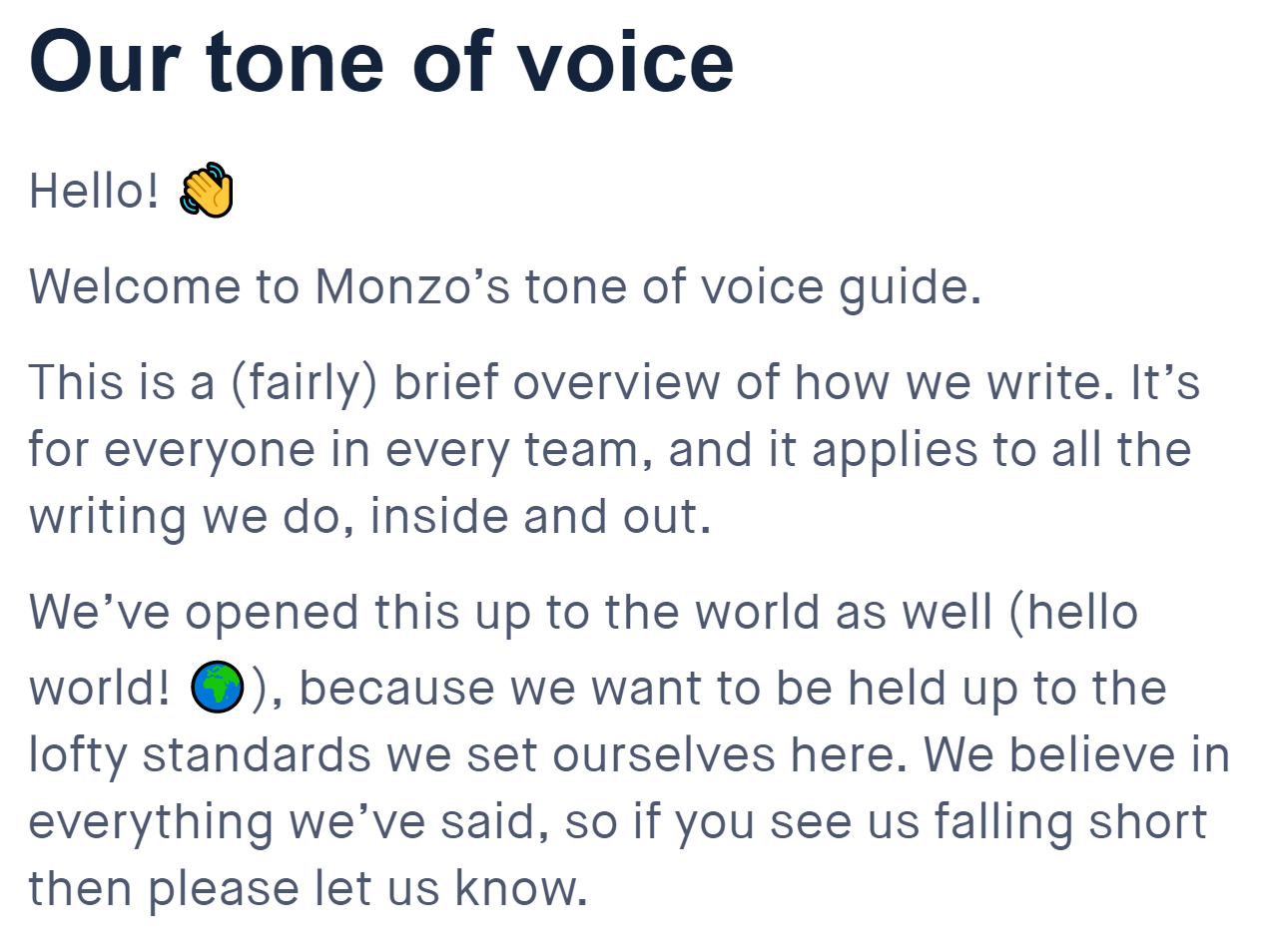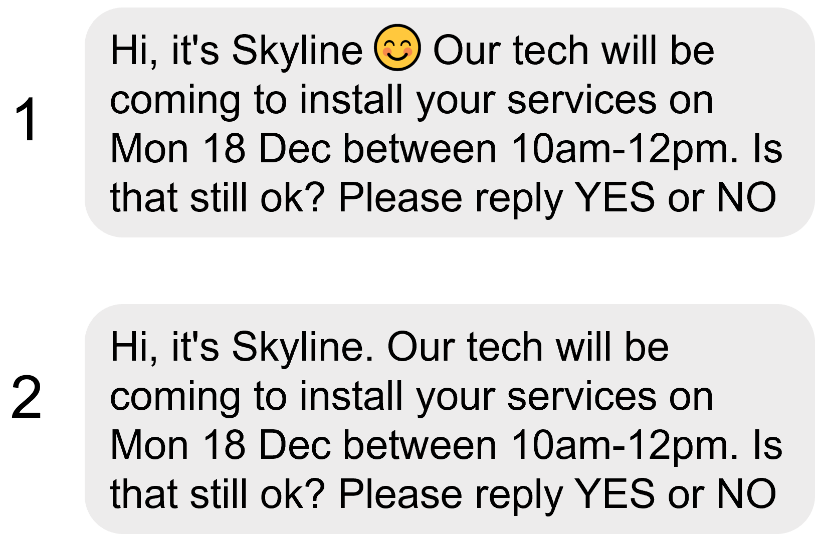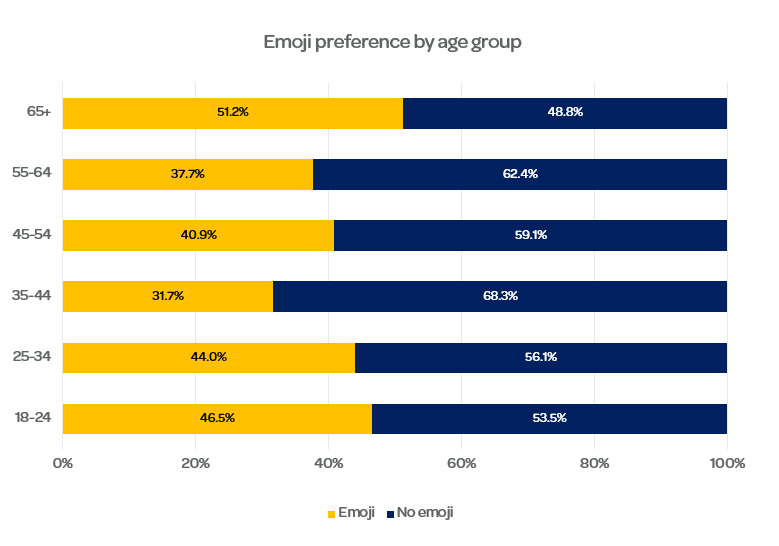To kick off the second instalment of my emoji series, let me ask: are you familiar with Monzo?
Monzo is a relatively new company which describes itself as ‘a bank in an app’ and which is doing very well[1]. You might have noticed its product even if you weren’t aware of Monzo itself, as their fluorescent orange-pink bank cards are hard to miss. There are many interesting things about Monzo, but one of the most interesting here is their brand, and specifically, their use of language.
Monzo’s ethos is to be modern and accessible; they make banking easier, simpler, and better suited to our futuristic, smartphone-heavy lifestyles. One way this comes across on their website and app and in their communications is their use of emoji. They have a whole section on the website dedicated to explaining their approach to language and tone of voice, which, in my role as Linguistics Dweeb, spoke to me. An example is below[2]:

I’d really recommend reading the page – it’s clear, professional, thoughtful and for that reason, just quite soothing. For the purposes of this blog, though, let’s focus on just one aspect of Monzo’s language: the emoji! There they are, sprinkled through the webpage! As they go on to explain in the final section of the webpage, Monzo use emoji because it reflects their friendly, progressive approach. But, as they make sure to clarify, they use them sensibly – not all the time, not to replace words, and with careful consideration of the context.
In my previous blog, I mentioned that demographic groups tend to have very different attitudes towards emoji. Women use them more than men; older groups use them less than younger. And so on.
Although interesting, these statistics are broad and they don’t acknowledge the context of the emoji – the bigger picture, if you will (sorry) – which means we’re only getting half the story. As I never fail to bang on about, language is context-dependent. You communicate differently with the CEO of your company (Hi Mark 👋) than you do with your mum (Hi Mum 😘). Equally, writing a complaint email is different from using a webchat service, which is different again from replying to a company’s text or interacting with a business on social media.
There are many brands that already employ emoji successfully. A recent study found that the use of emoji in advertising meant that consumers were more likely to view the product positively and more likely to purchase it. 👍 However, this was moderated by the type of product being advertised. The study found that emoji were more effective in promotion when the products being advertised were ‘hedonic’, that is: relating to enjoyment; non-essential. For utilitarian products, emoji were less effective[3]. Although this makes intuitive sense, an aforementioned counter-example is Monzo – as I’ve said, they’re doing really well!
But how weird is it for companies to use emoji?
This is an extremely broad question, and as I said earlier while enjoying the view from my soapbox, it depends on the context! So – to begin to answer it in a ContactEngine-specific context at least, we did some research. Participants were asked to imagine that they had arranged an appointment with a services company, and that the company sent a text asking them to confirm it. We asked: which of the two messages below would they prefer to receive? The only difference between them was, of course, the emoji:

Results were surprising! Across participants there was a fairly even split, with people slightly preferring the non-emoji message. This indicates a fairly positive view of companies use of emoji in this context – it’s not necessarily off-putting and for some, it’s preferable.
When we cut the data by age group, things got more interesting, as shown in the graph:
As we might have predicted, younger age groups were keener on emoji, with 18-34-year-olds being more likely to prefer the emoji message than 35-64-year-olds were. This confirms our preconceptions: those millennials! They love their emoji[4]!
However, take a look at the 65+ age group. This was the only one for which respondents were more likely to choose the emoji message than the non-emoji one. The difference was small, but it is there.
This might not be entirely unexpected, looking at anecdotal evidence of your older friends and relatives going hard on the smiley faces. Broadly speaking, millennials tend to use emoji quite comfortably, as they're a relatively new invention and millennials probably grew up alongside them as they developed. As such, they're familiar with emoji and how to use them. The generations one or two above – so 35-64 year olds – are less comfortable, as they were already adults when emoji were introduced. But the 65+ generation – well, maybe they’re just embracing the change? They feel more comfortable about using emoji, because they’re a bit of fun that aids communication?
The good news is, we can use these demographic differences to our favour, as it’s another way of personalising customer conversations. I’ve previously talked about breaking down language into its component parts to identify the most successful way of communicating. Emojis are very much included in this, and using them (carefully) could be another way to appeal to customers and improve experience of our services.
ContactEngine conducts conversations with customers and at the moment, we don’t start conversations that include emoji. But we often receive customer responses that do. So the reasoning is this: if people like emoji enough to send them, they will probably like receiving them too; if people consider emoji formal enough to send to a company, they probably won’t consider it strangely informal if the company sends one back.
So perhaps these customers are trying to tell us something. Don’t ignore our wants and needs, they might be saying. Please listen to us, they beg. Use emoji, and we will treasure your conversations far more than otherwise, I hear their desperate cries.
Only time (or rather, further research and testing) will tell.
_________________________________________________________________________
[1] Keene, Duncan (2017). ‘What Can We Learn From Monzo’s Success?’ Fintech Finance. https://www.fintech.finance/01-news/what-can-we-learn-from-monzos-success/
[2] Monzo’s ‘Our tone of voice’ page: https://monzo.com/tone-of-voice/
[3] Das, Gopal, Hillary J.D. Wiener & Ioannis Kareklas (2019). ‘To emoji or not to emoji? Examining the influence of emoji on consumer reactions to advertising’, Journal of Business Research, 96, 147-156.
[4] They just can’t get enough: https://www.getcloudapp.com/blog/why-millennial-consumers-love-emoticons





